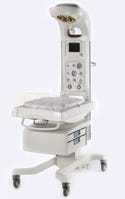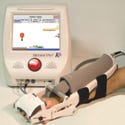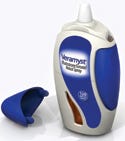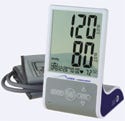Design Appeal: The Patient Perspective
Designing devices with the patient in mind means that the patient is more likely to have a better experience with a product—and more likely to continue using it.
April 1, 2008
MDEA 2008
No pain. More comfort. More attractive. And, how about more fun? This year's Medical Design Excellence Awards turned up more than a few winners that made appeal to the patient a top priority. One promises little or no pain for a traditionally terrifying dental injection. Others make the patient—or in one case, the patient's parent—feel more at ease. Some were designed to fit into the patient's home décor. And another simply makes the product fun so that the patient will stick with the therapy.
“Clearly, enhanced performance and patient experience is an appropriate and useful design opportunity, benefiting patients—and the company, if it is able to achieve a business advantage,” says juror William Hyman, a professor of biomedical engineering at Texas A&M University.
Jurors attribute the trend to several factors. “Demands by users are being heard, in part, because of the shortage of nurses and similar caregivers,” says juror Craig Jackson, PhD. Jackson is president of Hemosaga Diagnostics Corp. (San Diego). “Also, there is competitive pressure. If pricing is somewhat inelastic, then innovative features are necessary to make one product desirable over another,” he says.
“The reason for the trend toward positive user experiences is that this topic is getting more attention among designers of all types of devices,” says juror Molly Story. Story is president of Human Spectrum Design LLC.
“It might also be that FDA's requirement that medical device developers use a human factors process is causing them to pay more attention to the user experience in general,” she says.
Overcoming the Fear of the Dentist
|
The STA system controls the flow rate of a dental injection so that pain is maintained below human perception. |
The Single Tooth Anesthesia (STA) system by Milestone Scientific Inc. (Livingston, NJ) addresses a long-dreaded dental fear. The system precisely controls the flow rate of the injection so that it can be maintained below the human pain perception level, resulting in an injection that the company says is “a truly painless experience to the patient.” The initial intended use is for dentistry, but the company says that future versions will be suitable for medical injections and other medical applications.
“This product is patient friendly because it limits the area of the mouth that gets anesthetized, and the dentist controls the speed, and therefore the pressure, at which he inserts the anesthesia solution,” says Story. “Both of these reduce the discomfort the patient experiences. The technological breakthrough is the feedback mechanism that communicates to the dentist how much pressure he is applying as he inserts the solution.”
The system uses a computer-controlled sensing technology to deliver the anesthetic. Continuous audible and visual real-time pressure feedback allows the clinician to accurately identify a specific anatomic target for the injection based on the interstitial tissue pressure. According to the company, the STA system performs a dental injection that is typically very difficult and painful to perform when using a syringe. With the system, however, a single tooth can be anesthetized without producing numbness to the patient's lip, tongue, or other teeth.
“The innovation here was truly technical in that the pressure feedback system identifies the target tissue's location and thereby allows delivery of the drug with less pain and greater efficacy and localization,” says Hyman.
Hyman notes that “the patient-friendly part” of the design is the actual reduction in pain and greater comfort, especially in the dental environment, which is not known for patients enjoying their experience. “In a broader sense, a pain-free experience might lead to a more timely return for subsequent dental treatment, thereby contributing to individual and public health,” he says.
A Warm and Fuzzy Experience
|
Full-color panels and trending are among many features designed to provide an optimum environment not only for patients, but also for caregivers and visiting parents. |
GE Healthcare's two infant warmers—the Panda iRes and the Giraffe—have a sleek, modern design that the company says appeals to clinicians and families alike. “Our Panda and Giraffe warmers are the result of five years of intensive research into customer, patient, and clinical needs in neonatal intensive care (NICU) and in well baby care,” says Mike Genau, vice president, and general manager of GE Healthcare, Maternal & Infant Care.
“The overall aesthetic of the GE warmers is open and friendly,” notes juror Sandra Miller. “The monitoring is displayed with a simple user interface that is not frightening in appearance for parents who have enough to worry about if their baby is in the neonatal intensive care unit,” she says. Miller is managing director of the Stanford Biodesign Program at Stanford University.
Another feature of the warmers is a rotating mattress—called the Baby Susan. It reduces the frequency and duration of procedural contact. “The Baby Susan helps decrease negative touches for the fragile NICU patient by allowing the clinician to position the baby with a rotating mattress,” says Genau. “Our customers tell us that one of the most significant features of the Giraffe and Panda platforms is the hands-free alarm silence, allowing the clinician to silence alarms without touching the unit—which some studies suggest can be an area susceptible to contamination.”
“GE's warmers were particularly impressive because they elegantly addressed interface issues for the multiple users encountered in labor and delivery and in the neonatal intensive care units: the newborn patient, healthcare providers, and the parents,” adds Miller. Because the warmers have integrated the monitoring functionality normally addressed by other equipment, they also reduce clutter in the unit, a much-desired trait, she says. “It improves the newborn's experience with easier, friendlier handling.”
Sonic the Hedgehog Meets Medical Devices?
|
A video game–like interface provides an engaging and entertaining environment to stimulate patient effort and dedication during lengthy therapy sessions. |
A user-friendly feature of the Hand Mentor Pro Rehabilitation System is its video game–like patient interface. According to Kinetic Muscles Inc. (KMI), numerous games can be programmed to guide the patient through the rehabilitation steps. The interactive interface is designed to provide an entertaining treatment environment that stimulates patient effort and dedication during lengthy therapy sessions. The system promotes restoration of function in the wrist, hand, and fingers of stroke survivors and other neurological injury patients suffering from mild to moderate hemiplegia. The two-part system is designed for use under the guidance of occupational therapists.
“I think the Hand Mentor is a noble device that converts tedious physical therapy—repeated hand movement and stretching intended to reestablish good brain-to-hand communication after a stroke—into a more pleasing activity,” notes juror Michael Wiklund, president of Wiklund Research & Design Inc. (Concord, MA). “The software associated with the mechanical device asks patients to perform object-tracking tasks that promise to improve hand function, but turns it into an encouraging game.”
Ed Koeneman, founder and COO of KMI, talks about the user-interface development. “There are two groups of users that influenced the design of our device: stroke patients and their physical or occupational therapists. Extensive field testing of prototypes and early models were used to collect feedback from both groups. What we learned from the patients is that the therapy experience needed to be more interactive—more fun,” says Koeneman. “What we learned from the therapists is that a short learning curve and a more automated method of monitoring patient progress were essential to widespread adoption of this product.”
Koeneman explains that the key to successful neurological rehabilitation is extensive repetition. “But repetitious tasks can often be boring,” he says. “The games in the Hand Mentor Pro are designed to engage the patient for long periods of time. [Patients] focus on the game, not on the therapy.”
KMI has received positive feedback from the rehabilitation industry for its efforts. Barbara Feth, associate national director of therapy operations at HealthSouth, recently told the company, “What I like about KMI, compared with most other rehabilitation equipment companies, is that they listen to the patients and the therapists.”
“The most important feedback that we can get is from our beta testers. We have a handful of therapy clinics that we work very closely with in order to get very candid feedback on new design features. We value the tough love that we get from their comments and critiques of our products. If something isn't just right, they let us know, and we listen and do something about it,” says Koeneman.
The Customer Has Spoken
|
The Veramyst nasal spray package was designed to improve ease of use for both the patient and caregiver. |
Patient feedback and targeted voice-of-the-customer studies were of paramount importance to the design concept of the Veramyst and Avamys nasal spray packages by GlaxoSmithKline (GSK). According to GSK, this feedback led to the development of an ergonomically designed device that addresses important benefits in terms of ease of use by either the patient or their caregiver. The design incorporates comfort and reproducibility of dosing of an effective medication to improve symptom relief. “By listening to the customers, improved patient compliance can be achieved through
innovative design,” says GSK.
One of those attributes is the device's side-actuated delivery, which enables easy third-party administration by caregivers to children or to patients unable to administer it themselves. The design improves control for the administrator, and the side actuation is less invasive for the patient than top-actuated pumps.
“I've noticed that many drug manufacturers have introduced novel and innovative drug-delivery systems,” says Wiklund. “The Veramyst device is certainly an example of this, embodying features that make it easier to take the drug while also increasing the device's overall appeal. Whereas old nasal spray bottles were arguably annoying to use and made it hard to deliver an accurate dose, Veramyst is actually pleasing to use, maybe even fun to use. It appears to deliver a precise dose, due to the smooth action of the device's side lever,” he explains.
The device delivers a prescribed once-daily nasal spray for the treatment of seasonal and perennial rhinitis. According to the company, this device has been ergonomically designed using feedback from customers and human factors studies for ease of use by both a patient and a caregiver.
“I should add that the product's shape and graphics also contribute to the device's overall appeal. I expect that users' perception of Veramyst and its effectiveness is substantially enhanced by the device's attractive packaging and usability,” says Wiklund. “The trend toward user-pleasing drug-delivery systems is also reflected in the latest insulin pens, which makes accurate drug delivery a snap (actually, a click and press).”
Giving Patients Freedom
|
The Genesis DM made incremental improvements, such as an angled display that users can view while standing. |
The Genesis DM by Honeywell is the latest generation of the company's telehealth vital signs monitor. The device measures objective and subjective patient data for a complete picture of a chronic patient's health from home.
It is a Web-enabled device that also has general packet radio service communication capability.
“Honeywell has incorporated several user preference factors into the design of the new Genesis DM monitor. The major design modification was the introduction of an angled display area,” says Eric Zalas, emerging-segment marketing manager for Honeywell HomMed (Brookfield, WI). “Our focus group feedback indicated that patients wanted a device that was easy to read when they were standing. This simple design modification made it much easier for the elderly patient to read the graphic display,” he explains.
The Genesis DM provides remote patient biometric and symptom evaluation by measuring heart rate, blood pressure, weight, pulse oximetry, and blood glucose readings. It allows clinicians to remotely monitor the vital signs of chronically ill patients on a daily basis. It may help clinicians detect the onset of a negative outcome that may result in early rehospitalization. The Genesis DM is used by patients suffering from chronic conditions such as congestive heart failure, COPD, CAD, diabetes, and hypertension.
Zalas says that customer feedback also helped Honeywell design a monitor with a small footprint. “The Genesis DM is small enough to easily fit on a patient's nightstand. In addition, the Genesis DM weighs less than 2 lb, making it easy for patients to move it around the house if necessary,” he says.
Honeywell conducted primary research with its elderly Medicare patients during the design phase, says Zalas. “Most of the patients that use the monitor are over 70, and many are frail. We learned early in the process that patients didn't want to have a device in their homes that looked medical,” he says. Based on this input, Honeywell designed the Genesis DM to resemble an alarm clock or small stereo component.
Honeywell's ergonomic studies with the control buttons have resulted in a design for maximum ease of use for chronic patients. “Our research showed that elderly patients are easily confused by multiple buttons, so the Genesis DM was designed with simplicity in mind. Each of the six control buttons is large and color-coded. Each button also has a rounded-outward or convex surface that helps the patient feel when his or her finger is on exactly the right spot,” says Zalas.
Patients can use the Yes or No buttons on the monitor to answer more than 50 detailed disease-specific symptom-management questions. This feature allows physicians and clinicians to not only assess the patient's objective vital signs (i.e., weight, blood pressure, etc.), but also subjective inputs (e.g., “Are you feeling better today?” or “Are your ankles swollen?”), explains Zalas. “The patients like this feature because they can provide subjective feedback to their clinician on a routine basis.”
In Plain Sight? No Problem
|
Users can set the Healthy Living blood pressure monitor to issue a warning if certain blood pressure levels are exceeded. |
Those who suffer from hypertension, diabetes, and obesity are usually encouraged to watch their blood pressure and share the results with their healthcare provider. The Healthy Living ThinLine Deluxe flat-screen blood pressure monitor is intended for home monitoring of blood pressure. The twist? When not in use, it sits nicely on a desk or table and functions as a clock.
“The design brings this out from under the sink and puts it in your life,” says the company. “It is now part of your nightstand or desk, and seeing it will remind you to take your blood pressure.” The design is intended to make it the process more relaxed and commonplace. “It does what it's supposed to do—measure blood pressure—and does so with a sleek, modern look,” says Healthy Living. Users can also set the monitor to warn them if certain levels are exceeded.
“The dual function of this product—a blood pressure monitor as well as a household object—is innovative because it transforms a medical product that can be seen as stigmatizing into a friendly and common everyday object. Is it indicative of a trend, perhaps, for simple products like this one,” says juror Pascal Malassigné, professor of industrial design at the Milwaukee Institute of Art and Design.
“The see-through screen with its large text and numerals facilitates viewing from a distance. Everyone in the household benefits: youngsters, adults, and older family members. . . . [Its] a true example of universal product design,” says Malassigné.
Conclusion
Modern living has made patients much more aware of what is pleasing to them. They have become more vocal in letting their healthcare providers know what works for them personally. For OEMs, that translates to incorporating patient demands into their designs.
“The word pleasing may be too weak,” notes Hyman. “I don't want to just be pleased. I want my medical experience enhanced with respect to efficiency of my time, reduction of anxiety and pain, and efficacy of treatment. These issues to me go beyond pleasing.”
As a trend, satisfying patients could be a business opportunity to create or secure a niche. There is more opportunity through improvements than through breakthroughs. “Improvements also are likely to present a lower regulatory hurdle, especially if you are improving your own product,” Hyman says.
There is more to making a device easier to use than just improving functionality. Human factors, ergonomics, patient studies—these are just a few of the methods that were part of the design process for some of the 2008 MDEA winners. Whether the results made a process less painful or a device more pleasing, appealing to the patient was a key factor in the designs.
Copyright ©2008 Medical Device & Diagnostic Industry
About the Author(s)
You May Also Like







.png?width=300&auto=webp&quality=80&disable=upscale)
